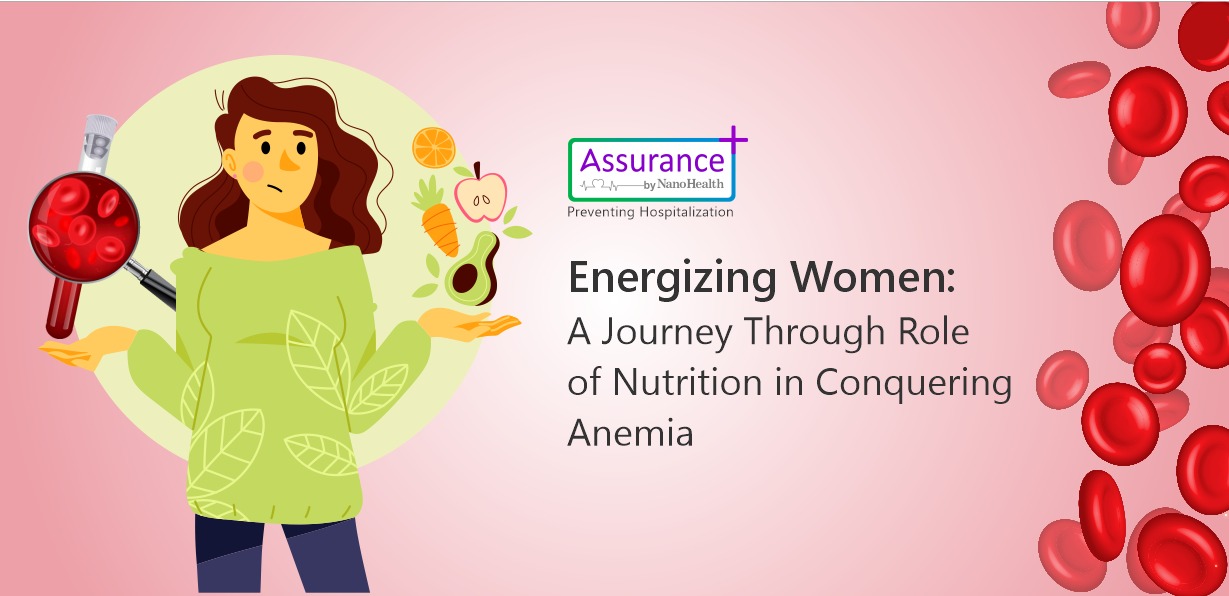

Energizing Women: A Journey Through Nutrition's Role in Conquering Anemia
Picture this: Anemia, a stealthy villain prowling in the shadows of vitality, sapping energy and leaving its victims feeling weary and deflated. But here's the twist: it's not just any adversary – it has a preference for targeting women worldwide, with a staggering 28% of Corporate working women falling under its spell (according to WHO). Yet, amidst this seemingly grim scenario, a beacon of hope emerges, shining brightly with the transformative magic of Nutrition.
Anemia can arise from various factors, including inadequate nutrition, infections, chronic illnesses, excessive menstrual bleeding, complications during pregnancy, and familial predisposition. Often, it stems from insufficient iron levels in the bloodstream.
Understanding Anemia: More Than Just a Lack of Iron-
Anemia is often synonymous with iron deficiency, as iron plays a pivotal role in the production of hemoglobin, the oxygen-carrying component of red blood cells. Yet, the story of anemia extends beyond iron alone. Women face a myriad of challenges that predispose them to nutritional deficiencies, including menstruation, pregnancy, and lactation, all of which increase the body's demand for essential nutrients.
The Iron Paradox: Navigating Absorption and Inhibition-
Iron, hailed as the cornerstone of combating anemia, presents a paradox of sorts. While plentiful sources of iron exist in both plant and animal-based foods, its absorption can be hindered by various factors, such as the presence of inhibitors like tannins, phytates, and calcium. Thus, the key lies not only in consuming iron-rich foods but also in strategic pairing with enhancers such as vitamin C-rich fruits and vegetables, like amla, guava, kiwi and oranges etc which bolster absorption and efficacy.
Beyond Iron: Folate and Vitamin B12 as Unsung Heroes-
In the symphony of nutrition and anemia, folate (like spinach, chickpeas,lentils, black beans) and vitamin B12 (chicken, eggs, fish, milk, yogurt, cheese) ) emerge as unsung heroes. Deficiencies in these vital nutrients can also precipitate anemia, making it imperative to cast a wider net in our dietary pursuits. Leafy greens, legumes, fortified cereals, and an array of animal products serve as rich reservoirs of folate and vitamin B12, offering a multifaceted approach to combating anemia.
India boasts a rich culinary tradition teeming with iron-rich foods that are not only nutritious but also delicious. Here are some common sources of iron in Indian cuisine:
Leafy Greens: Leafy green vegetables like spinach (palak), fenugreek leaves (methi), amaranth leaves (lal saag), and mustard greens (sarson ka saag) are excellent sources of iron. These greens are versatile and can be incorporated into various dishes such as curries, stir-fries, and soups.
Legumes and Lentils: Lentils (dal) and legumes such as chickpeas (chana), black gram (urad dal), pigeon peas (toor/arhar dal), and kidney beans (rajma) are rich in iron. These pulses are staples in Indian cuisine and are used in a wide array of dishes including dals, curries, and soups.
Whole Grains: Whole grains like quinoa, amaranth (rajgira), and millets such as ragi (finger millet) and bajra (pearl millet) are not only nutritious but also contain good amounts of iron. These grains can be used to make porridge, rotis (flatbreads), and savory dishes.
Nuts and Seeds: Nuts and seeds like almonds, cashews, sesame seeds (til), and pumpkin seeds are packed with iron. These can be consumed as snacks, added to salads, or used as toppings for various dishes.
Fortified Foods: In addition to natural sources, fortified foods such as fortified cereals, flours, and beverages are also available in the Indian market. These products are enriched with iron and other essential nutrients to help combat deficiencies.
Dry Fruits: Dried fruits like apricots, raisins, dates, and figs are not only sweet treats but also contain significant amounts of iron. These can be enjoyed as snacks or added to desserts, smoothies, and breakfast bowls.
Herbs and Spices: Certain herbs and spices used in Indian cooking also contribute to iron intake. Examples include dried fenugreek leaves, coriander seeds, cumin seeds, and turmeric.
Meat and Seafood: For non-vegetarians, lean meats like chicken, turkey, and fish are good sources of heme iron, which is more readily absorbed by the body compared to non-heme iron found in plant-based foods.
Incorporating a variety of these iron-rich foods into your diet can help meet your daily iron requirements and promote overall health and well-being.
Charting a Path Forward: Empowerment through Education and Action
As we stand at the crossroads of nutrition and anemia, the path forward beckons with promise and possibility. Empowering women with knowledge, access to resources, and personalized healthcare interventions paves the way for a brighter, anemia-free future. By nurturing bodies, minds, and communities, we embark on a collective journey toward vitality, vitality, and unwavering resilience.
In closing, the battle against anemia in women is not merely a medical endeavor; it is a testament to the transformative power of nutrition, resilience, and empowerment. As we unite in our commitment to nourish, educate, and uplift, we illuminate the path toward a world where anemia is but a distant memory, and vitality reigns supreme.
RECIPES
RAJMA SOUP
Ingredients
-
Kidney beans boiled - 30 g
-
Tomato chopped - 20 g
-
Onion finely chopped - 20 g
-
Spinach chopped - 15 g
-
Capsicum finely chopped - 10 g
-
Vegetable stock - 2 cups
-
Olive oil - ½ tsp
-
Garlic crushed - 3 cloves
-
Bay leaf - 1no.
-
Red chilli chopped - 1 no.
-
Cinnamon powder - a pinch
-
Salt - to taste
-
Fresh coriander leaves chopped - 2 tsp
Directions:
Step 1
Heat olive oil in a nonstick pan; add garlic, cinnamon stick, bay leaf, and onions. Saute for 3-4 minutes.
Step 2
Add red chilies, and chopped spinach and saute for two minutes. Add tomatoes and cook for 3-4 minutes. Add capsicum, and cook for 2 minutes. Add kidney beans and vegetable stock. Allow the mixture to boil. Cook for 15 minutes on low heat.
Step 3
Remove from heat and allow the mixture to cool.
Step 4
Blend half of the mixture to a smooth paste. Mix both the mixtures together and boil again.
Step 5
Add cinnamon powder, salt, and fresh coriander leaves. Mix well and serve hot.
TANGY TWIST
Ingredients
- 1/2 cup Grapes, black
- 1/2 cup Pomegranate
- 3/4 cup Orange segments
- 12 Ice-cubes
Directions:
Step 1
Blend all the ingredients, using water if required.
Step 2
Strain away the pulp. Add ice cubes.
Step 3
Enjoy chilled with a hint of mint.
Assurance by NanoHealth: Your Trusted Healthcare Provider
Achieving tangible results with dietary interventions for health often involves a combination of strategic planning, consistency, and individualized approaches.
Remember, individual responses to dietary changes can vary. What works for one person may not work for another. Therefore, a personalized and evidence-based approach, guided by healthcare professionals, is essential for achieving positive outcomes in managing better health through dietary interventions.
At Assurance by NanoHealth, our personalized dietitians provide a comprehensive solution to the specific challenges associated with health. We prioritize assisting you in maintaining a balanced diet and safeguarding against health issues related to any deficiencies.
Let our team guide you towards embracing the changes in your health with vitality and optimal well-being. Book your consultation now and embark on a journey towards better health! Call +91 9100444004 or visit our website www.nhassurance.com to get started.
